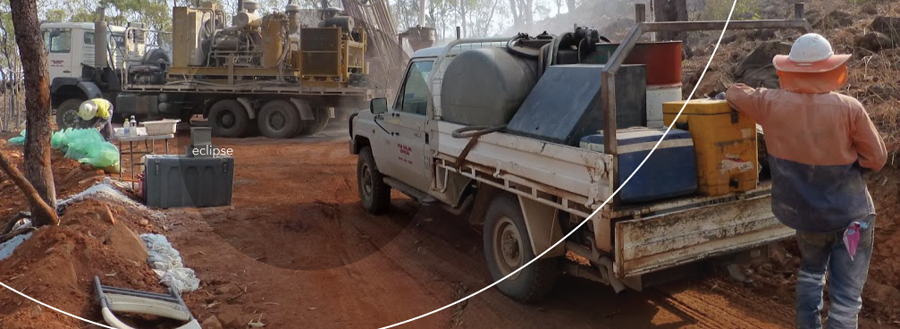Eclipse
The Eclipse mine working consists of a small open pit working a massive gossans.
In 1955, Metals Exploration NL (Hare, 1955) drilled 5 shallow inclined holes into the Eclipse. These holes intersected significant base metal mineralisation.
McIntyre Mines (Australia) Pty Ltd entered into a joint venture with North Interior Explorations over the mining leases covering the Eclipse open cut. McIntyre conducted geological mapping, soil sampling, ground magnetic and VLF-EM geophysical and gravity surveys. McIntyre drilled 4 diamond holes into the Eclipse skarn.
Numerous zones of Ag-Au-Zn-Pb-Cu mineralization were intersected in all the holes out of which 7-reached target depth.
Composite rock chip sampling by Barramundi Gold Ltd over the silica-iron gossans at Eclipse. Follow up sampling by Normandy obtained several samples .
Mineralization at the Eclipse is open to the East and West and down dip.
In 2008 mineralisation at Eclipse was interpreted by GeoRes as occurring in three reasonable consistent vertical to very steeply N dipping, sub-parallel liner lode structures.The lodes averaged ~3-5m in width and the longest (E02) had a strike of ~500m. Mineralisation remained open along strike and at depth.
Eclipse a consideration of past modelling, the Exploration Target estimation, distribution of existing drill holes, and all lodes being open along strike and to depth, lead GeoRes to conclude that extension and in-fill drilling would have positive results. A modest 400 m strike extension (80%), with a 50 m depth extension (50%) would increase envisaged tonnage by 145% (0.57 Mt to 1.40 Mt).
Eclipse a consideration of past modelling, the Exploration Target estimation, distribution of existing drill holes, and all lodes being open along strike and to depth, lead GeoRes to conclude that extension and in-fill drilling would have positive results. A modest 400 m strike extension (80%), with a 50 m depth extension (50%) would increase envisaged tonnage by 145% (0.57 Mt to 1.40 Mt).
In 1955, Metals Exploration NL (Hare, 1955) drilled 5 shallow inclined holes into the Eclipse. These holes intersected significant base metal mineralisation.
McIntyre Mines (Australia) Pty Ltd entered into a joint venture with North Interior Explorations over the mining leases covering the Eclipse open cut. McIntyre conducted geological mapping, soil sampling, ground magnetic and VLF-EM geophysical and gravity surveys. McIntyre drilled 4 diamond holes into the Eclipse skarn.
Numerous zones of Ag-Au-Zn-Pb-Cu mineralization were intersected in all the holes out of which 7-reached target depth.
Composite rock chip sampling by Barramundi Gold Ltd over the silica-iron gossans at Eclipse. Follow up sampling by Normandy obtained several samples .
Mineralization at the Eclipse is open to the East and West and down dip.

